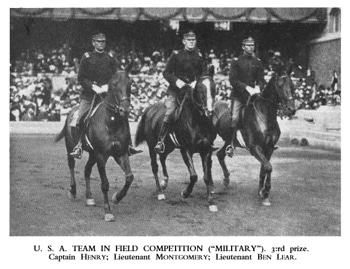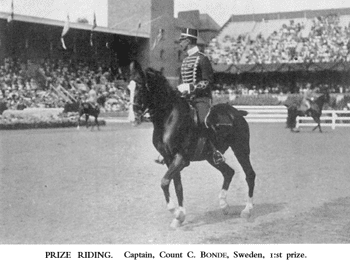This year the Summer Olympics takes place in Paris, France. As you may already know, this international competition includes three equestrian events; dressage, jumping, and eventing.
Olympic eventing first made its appearance in the 1912 Summer Games. At that time it was called “Military” and was open only to servicemen and army horses.
Twenty-seven riders representing seven countries took part in the first event: Denmark, Germany, Sweden, France, Belgium, Great Britain and the U.S., with all the countries except Denmark fielding a full team of four riders.
1. How many riders did Denmark have?

The 1912 event included an Endurance Test on day 1. Horses and riders first rode a 50 km long road ride, immediately followed by a 5 km cross-country course.
While there is no longer an endurance ride included in eventing competitions, there is cross-country. This year’s Olympic cross-country course is five thousand three hundred metres in distance with an optimum finishing time of 9min 18sec..
2. Write the distance of this year’s cross-country course in standard form.
3. Will this year’s Olympic cross-country course be longer or shorter than the cross-country course in the 1912 Olympics?
4. How much farther did horses have to go on in the Endurance Test in 1912 than in this year’s cross-country phase?

The team from Belgium
The 1912 course was marked by red flags but still, three riders were eliminated for going off course, and one rider exceeded the time limit (4 hours for endurance and 15 minutes for cross-country).
Twenty-two starters remained in the competition after the first day.
5. What percentage of riders were eliminated in the first day of competition? Round your answer to the nearest whole number.
Day 2 was a rest day and I’m sure both horses and riders needed it!
Then it was on to day 3 and a Speed Test. The remaining horses and riders competed over a 3500 m steeplechase course with 10 plain obstacles at a speed of 600 meters per minute. To more closely model the realism of war time conditions, the horses were required to carry a minimum of 80 kg (176 lbs.) during the jumping phases.
6. How many kilometres long was the steeplechase course?
7. If a rider weighed 74 kg (163 lb), how much weight would need to be added to meet the minimum requirement?

8. After the steeplechase competition, how many horse and rider teams remained?
Day 4 held the Jumping Test (“Prize Jumping”), or what we now call show jumping. In 1912, the course included 15 obstacles set to a maximum height of 1.3 meters and width of 3 meters wide.
In the 2024 Olympic Games in Paris, the maximum height and width for jumps is set at 125 cm high with a spread (or width) of 1.45 m.
9. Are the height of the jumps in the 2024 Olympic Games <, > or = the height of the jumps in 1912?
10. How much wider were the jumps allowed to be in the 1912 Olympics than in the 2024 Olympic Games?

Riders were required to enter the ring at a gallop, halt/salute, and then use the next 10 minutes to demonstrate figures at the walk, trot and gallop at both “collected” and “fast” speeds. Extra points were awarded for riding with primarily one rein or performing advanced movements such as the Spanish walk, piaffe or passage.
Unlike today’s straight dressage competition, the eventing horses were not required to perform figure-eights, flying changes, or the jumping and obedience tests.
In the end Sweden took Team Gold, led by Individual Gold Medalist Lieutenant Axel Nordlander. Germany followed in Silver position and the U.S. claimed Bronze.
What will happen in this year’s Olympic eventing competition? We’ll have to wait and see! In the meantime, here’s a fun video featuring the cross country event at the 2008 Games in Beijing.
Answers:
1. How many riders did Denmark have?
Answer: We know there were a total of 27 riders, and that a full team consists of 4 riders. We also know there are 7 countries competing.
If each country had a full team there would have been 4 (riders) × 7 (countries) = 28 riders.
But there weren’t. There were only 27 riders, with Denmark not fielding a full team.
28 (possible riders) − 27 (riders) = 1 rider.
Denmark was 1 rider short, with a team consisting of 3 riders.
2. Write the distance of this year’s cross-country course in standard form.
Answer: 5,300 m
3. Will the cross-country course in this year’s Olympics be longer or shorter than the cross-country course in the 1912 Olympics?
Answer: Longer. 5,300 m > 5 km (5,000 m)
4. How much farther did horses have to go on in the Endurance Test in 1912 than in this year’s cross-country phase?
Answer:
Step 1: 50 km = 50,000 m; 5 km = 5,000 m.
Step 2: 50,000 m + 5,000 m = 55,000 m.
Step 3: 55,000 m − 5,300 m = 49,700 m
Horses had to travel 49,700 m further in the 1912 Summer Olympic Endurance test.
5. What percentage of riders were eliminated in the first day of competition? Round your answer to the nearest whole number.
Answer:
Step 1: 27 (number of riders who started) − 22 (number of riders remaining after day 1) = 5 riders eliminated.
Step 2: 5/27 × 100% = 0.185 × 100% = 19%
6. How many kilometres long was the steeplechase course?
Answer: 3500 m = 3.5 km. The steeplechase course was 3.5 km long.
7. If a rider weighed 74 kg (163 lb), how much weight would need to be added to meet the minimum requirement?
U.S. Customary: 176 lb − 163 lb = 13 lb. Thirteen pounds would have to be added.
Metric: 80 kg − 74 kg = 6 kg. Six kilograms would have to be added.
8. After the steeplechase competition, how many horse and rider teams remained?
Answer: 22 − 3 = 19. Nineteen riders remained.
9. Are the height of the jumps in the 2024 Olympic Games <, > or = the height of the jumps in 1912?
Answer:
Step 1: 125 cm = 1.25 m.
Step 2: 1.25 m < 1.30m.
The height of the jumps in the 2024 Olympic Games is less than the height of the jumps in 1912.
10. How much wider were the jumps allowed to be in the 1912 Olympics than in the 2024 Olympic Games?
Answer:
3 m − 1.45 m = 1.55 m. The jumps were allowed to be 1.55 m wider in the 1912 Olympic event. More than twice as wide!
Common Core:
4.OA.A.3 Solve multistep word problems posed with whole numbers and having whole-number answers using the four operations, including problems in which remainders must be interpreted.
4.MD.A.1 – Know relative sizes of measurement units within one system of units including km, m, cm
5.MD.A.1 – Convert among different-sized standard measurement units within a given measurement system, and use these conversions in solving multi-step, real world problems.
6.RP.A.3c – Percents of numbers: word problems
Photos:
Belgian team from Harris & Ewing Collection; Library of Congress
All other photos Public Domain






